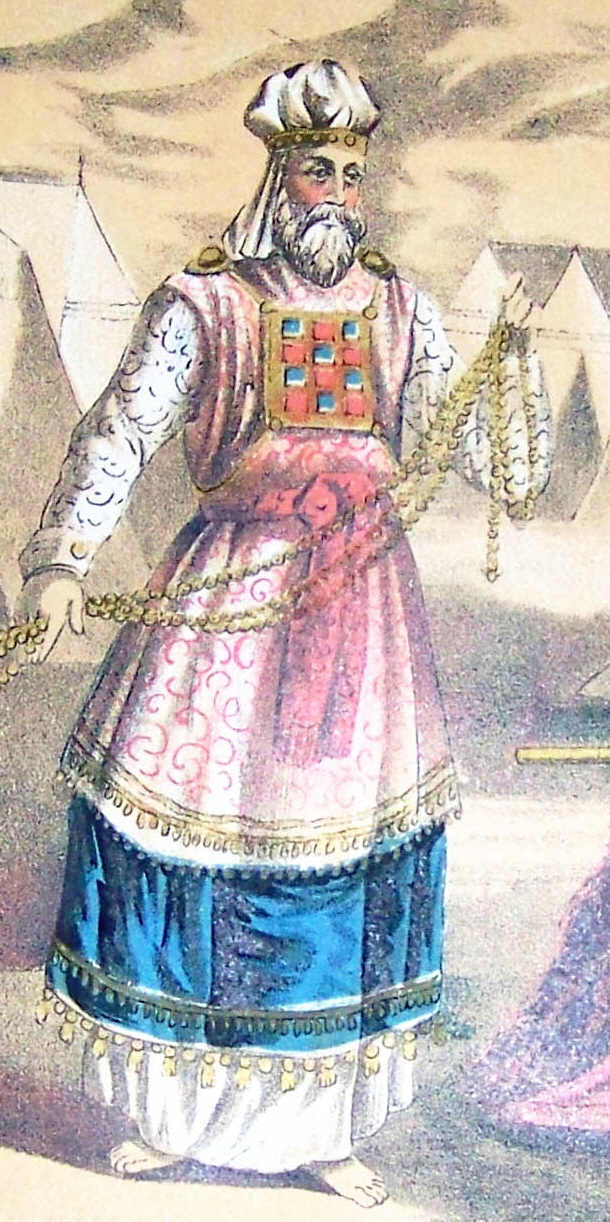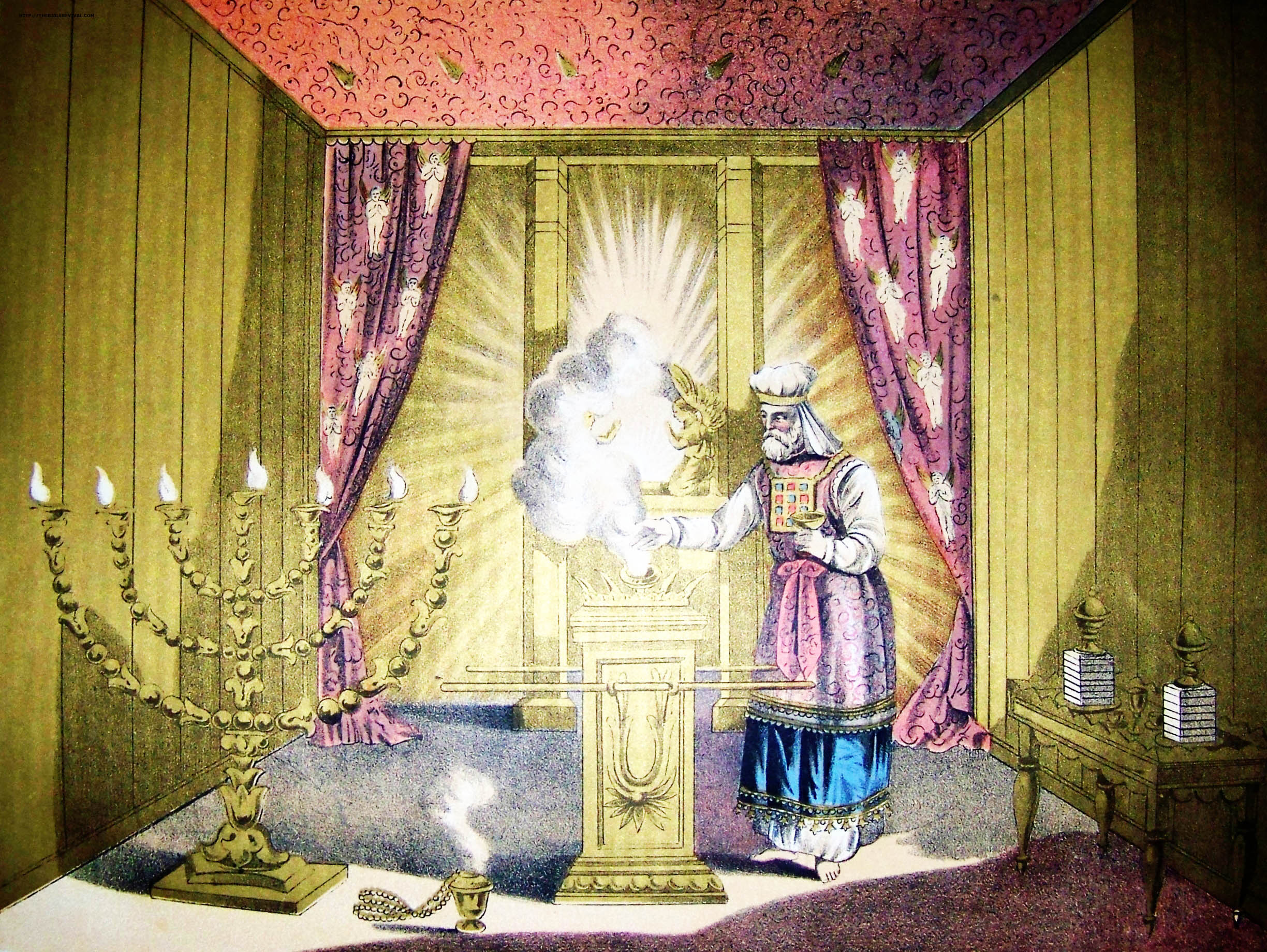|
Me'il
The priestly robe (), sometimes robe of the ephod ( ''məʿil hāʾēp̄oḏ''), is one of the sacred articles of clothing of the High Priest of Israel. The robe is described in Exodus 28:31-35. It was worn under the ephod. Like all the priestly garments, it was to be made by 'gifted artisans ... filled with the spirit of wisdom'. Hebrew Bible This Hebrew noun occurs 30 times in the Masoretic Text of the Hebrew Bible (𝕸) and refers not only to the robe of the high priest but also any robe worn over a tunic by men of rank, such as the robe Jonathan gave to David, or his mantle which Job tore in desperation, and also the outer cloak of women, such as the robe worn by David's daughters. It was a sleeveless, purple-blue or violet robe, woven in a single piece. The opening in the center for the High Priest's head to pass through was woven, not cut or torn (). The lower hem of the garment was fringed with small golden bells alternating with pomegranate-shaped tassels of blue (tur ... [...More Info...] [...Related Items...] OR: [Wikipedia] [Google] [Baidu] |
Tetzaveh
Tetzaveh, Tetsaveh, T'tzaveh, or T'tzavveh (, the second word and first distinctive word in the parashah) is the 20th weekly Torah portion (, ''parashah'') in the annual Jewish cycle of Torah reading and the eighth in the Book of Exodus. The parashah reports God's commands to bring olive oil for the lamp (, '' Menorah''), make sacred garments for the priests (, ''kohanim''), conduct an ordination ceremony, and make an incense altar. It constitutes Exodus 27:20–30:10. The parashah is made up of 5430 Hebrew letters, 1412 Hebrew words, 101 verses, and 179 lines in a Torah scroll. Jews read it the 20th Shabbat after Simchat Torah, in February or March. Readings In traditional Sabbath Torah reading, the parashah is divided into seven readings, or , '' aliyot''. First reading—Exodus 27:20–28:12 In the first reading, God instructed the Israelites to bring Moses clear olive oil, so that Aaron and his descendants as High Priest could kindle lamps regularly in the Tabernacle. ... [...More Info...] [...Related Items...] OR: [Wikipedia] [Google] [Baidu] |
High Priest Of Israel
In Judaism, the High Priest of Israel (, lit. ‘great priest’; Aramaic: ''Kahana Rabba'') was the head of the Israelite priesthood. He played a unique role in the worship conducted in the Tabernacle and later in the Temple in Jerusalem, as well as in some non-ritual matters. Like all priests, he was required to be descended from Aaron (the first biblical priest). But unlike other priests, the high priest followed more restrictive laws, wore unique priestly garments, and was the only priest allowed to perform certain ceremonies. Titles The high priest is referred to by a number of titles in the Hebrew Bible; the title ''kohen gadol'' did not become dominant until well into the Second Temple period. In addition to the title of "great priest" (''kohen gadol'') which later became the standard Hebrew title, the term "head priest" (''kohen harosh''; ) was used, as was "anointed priest" (''kohen mashiach''; )., , The Torah sometimes uses longer descriptions: "the great priest ... [...More Info...] [...Related Items...] OR: [Wikipedia] [Google] [Baidu] |
Pomegranate
The pomegranate (''Punica granatum'') is a fruit-bearing deciduous shrub in the family Lythraceae, subfamily Punica, Punicoideae, that grows between tall. Rich in symbolic and mythological associations in many cultures, it is thought to have originated from Afghanistan and Iran before being introduced and exported to other parts of Asia, Africa, and Europe. It was introduced into Spanish America in the late 16th century and into California by New Spain, Spanish settlers in 1769. It is widely cultivated throughout West Asia and the Caucasus region, South Asia, Central Asia, North Africa, north and tropical Africa, the drier parts of Southeast Asia, and the Mediterranean Basin. The fruit is typically in season in the Northern Hemisphere from September to February, and in the Southern Hemisphere from March to May. The pomegranate and its juice are variously used in baking, cooking, juice blends, garnish (food), garnishes, non-alcoholic drinks, and cocktails. Etymology The name ... [...More Info...] [...Related Items...] OR: [Wikipedia] [Google] [Baidu] |
Priestly Undergarments
The priestly undergarments () were "linen breeches" ( KJV) worn by the priests and the High Priest in ancient Israel. They reached from the waist to the knees and so were not visible, being entirely hidden by the priestly tunic. Hebrew Bible The biblical commandment instituting their use is found in the Book of Exodus 28:42: You shall also make for them linen breeches to cover their nakedness; they shall extend from the hips to the thighs. Unlike the other priestly vestments which were "for glory and for beauty" (Exodus 28:2), the purpose of the () was for modesty, "to hide their nakedness". In the Book of Leviticus when Moses consecrates Aaron and his sons as High Priest and priests, respectively, the linen undergarments are not mentioned (Leviticus 8:7, Leviticus 8:13), though their use is obviously presumed. There were four holy garments worn by both the priests and the High Priest alike: * Linen breeches to cover their nakedness when they enter the Tent of Meeting or ... [...More Info...] [...Related Items...] OR: [Wikipedia] [Google] [Baidu] |
Priestly Turban
The priestly turban or mitre () was the head covering worn by the High Priest of Israel when he served in the Tabernacle and the Temple in Jerusalem. Etymology The Hebrew term for the priestly turban has been translated as "mitre" ( KJV) or "headdress". It was most likely a turban, as the word comes from the root "to wrap". Hebrew Bible The turban worn by the High Priest was much larger than the head coverings of the priests. It was wound so that it formed a broad, flat-topped turban, resembling the blossom of a flower. The head covering of the priests was different, being wound so that it formed a cone-shaped turban, called a ''mīgbāʿā'' (). It was made of fine linen in Exodus 28:39, and like all the holy garments, it was made by "gifted artisans ... filled with the spirit of wisdom" according to Exodus 28:3. Rashi writes that the High Priests' turban was identical to the turbans of the other priests. The priestly golden head plate () was attached to the turban using tw ... [...More Info...] [...Related Items...] OR: [Wikipedia] [Google] [Baidu] |
Priestly Tunic
The priestly tunic ( ''kutonet'') was as an undergarment or shirt worn by the High Priest and priests when they served in the Tabernacle and the Temple in Jerusalem.Theological Dictionary of Rabbinic Judaism: Part Three Page 53 Jacob Neusner - 2005 "C. "This is in accord with the following teaching, which we have learned in the Mishnah . Yoma 7:5 "The high priest serves in eight garments, and an ordinary priest in four: tunic, underpants, head-covering, and girdle." Etymology The Hebrew noun ''kutónet'' () is the generic term for a tunic in Hebrew. The first use is the "coats" of skins made for Adam and Eve in Eden, the best known use would be the coat of many colours of Joseph. It is related to, and may be the source of, the Greek noun ''kiton'' ''(chiton)'' "tunic." Instructions for making the tunic It was made of pure linen, covering the entire body from the neck to the feet, with sleeves reaching to the wrists. That of the High Priest was embroidered (); those of the ... [...More Info...] [...Related Items...] OR: [Wikipedia] [Google] [Baidu] |
Priestly Sash
The priestly sash or girdle (Hebrew ''avnet'') was part of the ritual garments worn by Jewish high priests who served in the Temple in Jerusalem. The "sash" or "girdle" worn by the High Priest was of fine linen with " embroidered work" in blue, purple and scarlet (, ); those worn by the priests were of white, twined linen. The sash should not be confused with the embroidered belt of the ephod. Like the other priestly vestments, the purpose of the sash was "for glory and for beauty" (). On the Day of Atonement the High Priest changed into special linen garments that included a sash of fine linen without any embroidery (). These linen garments were worn only once, with new ones being made each year. Rabbinical commentary According to Rabbinical literature, Midrash and Maimonides, the sash was 32 cubits long and 2, 3 or 4 fingers wide. At this length, it would have to have been wound around the body several times. Theories differ as to how this was accomplished: some say ... [...More Info...] [...Related Items...] OR: [Wikipedia] [Google] [Baidu] |
Priestly Golden Head Plate
The priestly golden head plate, crown or frontlet () was the golden plate or tiara worn by the Jewish High Priest on his mitre or turban whenever he would minister in the Tabernacle or the Temple in Jerusalem. Etymology The root ''tzitz'' (צִיץ) means “to blossom” or “a flower” and as such is employed by the picturesque metaphors in Isaiah 27:6, 28:1, 40:7-8, floral descriptions of Solomon’s temple (1 Kings 6:18-35) and the blooming of Aaron’s rod (Num. 17:23). This latter instance is particularly interesting, because just as a ''tzitz'' appeared on the Aaron’s rod so is the Aaronide high-priest supposed to wear a ''tzitz'' on his forehead. In addition to this, once in the Hebrew Bible, in Ezekiel 8:3, the word appears in the construction ''tzitzit rosh'' meaning “a mop of hair” and probably deriving from the metaphor of hair as the plants grown from skin. This is furthermore supported by a handful of rabbinic descriptions which compare the priestly ''tz ... [...More Info...] [...Related Items...] OR: [Wikipedia] [Google] [Baidu] |
Priestly Breastplate
The priestly breastplate or breastpiece of judgment ( ''ḥōšen'') was a sacred breastplate worn by the High Priest of Israel, High Priest of the Israelites, according to the Book of Exodus. In the biblical account, the breastplate is termed the ''breastplate of judgment'' ( ''ḥōšen mišpāṭ'' – ), because the Urim and Thummim ( ''hāʾūrīm wəhattummīm'') were placed upon it (). These elements of the breastplate are said in the Exodus verse to carry the judgment ( ''mišpāṭ'') of God concerning the Israelites at all times. Hebrew Bible According to the description in Exodus, this breastplate was attached to the tunic-like garment known as an ephod by gold chains/cords tied to the gold rings on the ephod's shoulder straps and by blue ribbon tied to the gold rings at the belt of the ephod. The biblical description states that the breastplate was also to be made from the same material as the ephod—embroidery of 3 colors of dyed wool and linen—and was to be o ... [...More Info...] [...Related Items...] OR: [Wikipedia] [Google] [Baidu] |
Kittel
220px, A kittel A ''kittel'' ( ) is a white linen or cotton robe worn by some religious Ashkenazi Jews on holidays, in the synagogue or at home when leading the Passover seder. Grooms sometimes wear kittels. It is also customary for Jews to be buried in a kittel, at which time it is referred to as a tachrichim. History In Ashkenazic tradition, married men wear a kittel in the synagogue on Yom Kippur. In less-traditional synagogues, religious Jews—both men and women—wear a kittel. Some wear a ''kittel'' when leading the Passover Seder. In some communities, the hazzan wears a kittel on the first night of Selichot, on Hoshana Rabbah or the seventh day of the Jewish holiday of Sukkot, the musaf prayers of Shemini Atzeret and the first day of Passover, where the Geshem (prayers for rain or dew) are recited. In some communities, a bridegroom wears a ''kittel'' on his wedding day. In some communities, it is known by the Western Yiddish term ''sargenes'', related ... [...More Info...] [...Related Items...] OR: [Wikipedia] [Google] [Baidu] |
Ephod
An ephod (; or ) was a type of apron that, according to the Hebrew Bible, was worn by the High Priest of Israel, an artifact and an object to be revered in ancient Israelite culture, and was closely connected with oracular practices and priestly ritual. In the Books of Samuel and Books of Chronicles, David is described as wearing an ephod when dancing in the presence of the Ark of the Covenant (2 Samuel 6:14, 1 Chronicles 15:27) and one is described as standing in the sanctuary at Nob, with a sword behind it (1 Samuel 21:9). In the book of Exodus and the Book of Leviticus, one is described as being created for the High Priest to wear as part of his official vestments (Exodus 28:4+, 29:5, 39:2+; Leviticus 8:7). Description In the Bible, in the contexts where it is worn, the ephod is usually described as being linen, but did not constitute complete clothing of any kind, as the Books of Samuel describe.Cheyne and Black, ''Encyclopedia Biblica'' 1 Chronicles 15 states that Dav ... [...More Info...] [...Related Items...] OR: [Wikipedia] [Google] [Baidu] |
Israelites
Israelites were a Hebrew language, Hebrew-speaking ethnoreligious group, consisting of tribes that lived in Canaan during the Iron Age. Modern scholarship describes the Israelites as emerging from indigenous Canaanites, Canaanite populations and other peoples.Mark Smith in "The Early History of God: Yahweh and Other Deities of Ancient Israel" states "Despite the long regnant model that the Canaanites and Israelites were people of fundamentally different culture, archaeological data now casts doubt on this view. The material culture of the region exhibits numerous common points between Israelites and Canaanites in the Iron I period (c. 1200–1000 BCE). The record would suggest that the Israelite culture largely overlapped with and derived from Canaanite culture ... In short, Israelite culture was largely Canaanite in nature. Given the information available, one cannot maintain a radical cultural separation between Canaanites and Israelites for the Iron I period." (pp. ... [...More Info...] [...Related Items...] OR: [Wikipedia] [Google] [Baidu] |



